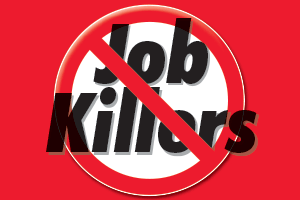 An economic analysis released last week found that a health care industry wage increase proposal would increase costs for public and private health care providers by $8 billion each year. If passed, this California Chamber of Commerce job killer measure would also increase costs to state and local governments by $4.8 billion annually.
An economic analysis released last week found that a health care industry wage increase proposal would increase costs for public and private health care providers by $8 billion each year. If passed, this California Chamber of Commerce job killer measure would also increase costs to state and local governments by $4.8 billion annually.
The bill, SB 525 (Durazo; D-Los Angeles), imposes significant costs on health care facilities and any employer who works with health care facilities by mandating an increase in the minimum wage to $25.
A broad coalition of community clinics, hospitals, doctors, minority business advocates, seniors and consumers is opposed to SB 525 because it would significantly raise costs and would lead to hospital cutbacks and closures.
“Health care providers go to great lengths to support and reward workers, but SB 525 is a massive $8 billion increase in health care costs we simply cannot afford,” said Cathy Martin, chief executive officer, Association of California Healthcare Districts. “Cost increases of this magnitude on an already fragile health care system will lead to cuts and closure of services, health care worker job losses, and massive cost increases for consumers and state and local governments.”
The bill’s broad language also covers employers of all sizes outside of the health care sector, including those that may employ any worker who sets foot on the premises of a health care facility or who performs any “health care service” for a facility. In a letter submitted to legislators, the CalChamber pointed out that these services are broadly defined to include janitorial staff, food service, laundry, and more.
“The astronomical increase in labor costs that will result from SB 525 is simply not sustainable,” the CalChamber said.
Study Key Findings
 The economic report, which was compiled by California’s former director of the Department of Finance and the former chief economist for the California State Legislative Analyst’s Office, found that if SB 525 were to pass, public and private health care expenses would increase by $8 billion each year and would increase to $11.3 billion annually by 2030.
The economic report, which was compiled by California’s former director of the Department of Finance and the former chief economist for the California State Legislative Analyst’s Office, found that if SB 525 were to pass, public and private health care expenses would increase by $8 billion each year and would increase to $11.3 billion annually by 2030.
Of the $8 billion, $4.9 billion in costs would be related to wage increases for workers making less than $25 an hour, and $1.5 billion in costs would go to employers offsetting wage compression by raising pay rates for employees earning up to double the new $25 per hour minimum wage.
The study also estimated that costs to state and local governments will be $4.8 billion annually, with all levels of government directly affected by the minimum wage increase. This is because state and local governments are employers of workers in state and county hospitals and correctional facilities; and are major purchasers of health care services—through county health care programs, the state’s Medi-Cal program, and as purchasers of health insurance for their active and retired employees.
The following are anticipated costs for state and local governments:
- Total State Government Costs: $4.01 billion
- Medi-Cal: $3.6 billion
- State Employee Health Insurance: $112.9 million
- Department of Corrections: $53.4 million
- Department of State Hospitals: $19.7 million
- State Retiree Health Insurance: $78.5 million
- California State University Retiree Health Insurance: $11.8 million
- University of California (UC) Employee Health Benefits: $74.6 million
- UC Retiree Health Benefits: $10.3 million
- Total Local Government Costs: $770.9 million
- County Health Program Costs: $406 million
- County, City, Special District (including School District) Employee Health Insurance Costs: $364.9 million
Staff Contact: Ashley Hoffman

